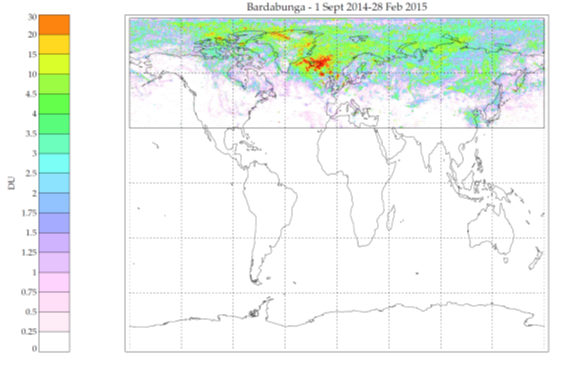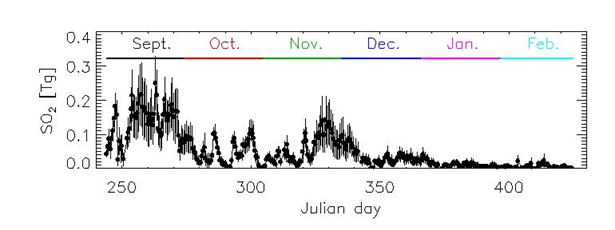The 2014-2015 Holuhraun eruption was a major source of sulfur dioxide (SO2) to the troposphere. Yet the number of ground-based SO2 measurements was limited, particularly during the Icelandic winter. This work involved the retrieval of a time series of volcanic SO2 atmospheric loading and vertical distribution from IASI over the entire eruption period from September 2014 to February 2015.
This study used all the IASI spectral range from 1000 to 1200 cm-1 and from 1300 to 1410 cm-1 (the 7.3 and 8.7 μm SO2 absorption bands) to retrieve both the SO2 amount and the altitude of the plume.
The SO2 band around 8.7 μm (1000 to 1200 cm-1) is within an atmospheric window range where radiation from the surface can reach the satellite measurements through all the atmospheric layers. This allowed retrieval of the SO2 amount down to the surface and lower troposphere. A comprehensive error budget for every pixel is included in the retrieval.
To check the validity of the retrieval, the IASI dataset was compared with Brewer ground measurements located at Sodankylä (Finland). This showed that all the SO2 episodes are consistent between satellite and ground measurements.
Evolution of the plume (maps of amount and altitude) was studied for the 6-month period where volcanic SO2 was transported in the lower troposphere all over the north hemisphere from 30 to 90° north.
The figure below shows the maximum SO2 amount retrieved during the 6-month period and illustrates that the Holuhraun plume over-passed a large part of northern hemisphere and nearly all of the Arctic Circle.

Map showing the maximum of SO2 column amount (Dobson Unit – DU) retrieved within the considered area from 30 to 900° N (black rectangle) from September 2014 to February 2015
A new optimal estimation scheme was developed that uses the atmospheric loadings time series (below) to retrieve emission fluxes together with the average lifetime of SO2. Emission fluxes were obtained reaching values up to 200 kt/d and a ‘minimum’ total mass emitted of SO2 of 3.7±0.8 Tg with an average lifetime of 2.4 ±0.6 days.

